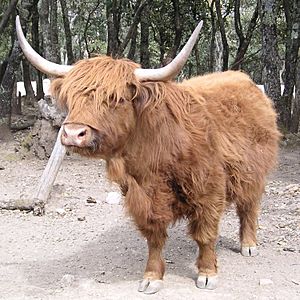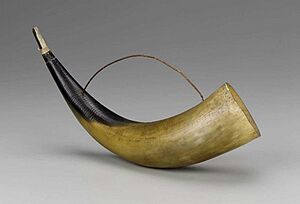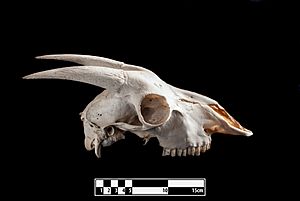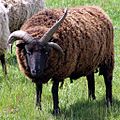Horn (anatomy) facts for kids
Horns are hard, pointy parts that grow on the heads of some animals. They are like natural helmets or tools! Most animals with horns have two, but some, like the rhinoceros, have just one horn right in the middle of their head. Horns are made of a tough material called keratin. This is the same stuff your own hair and nails are made of. Animals use their horns for many things, like protecting themselves or showing off. Long ago, people even used horns from animals to make musical instruments or to carry things like gunpowder.
Contents
What Looks Like a Horn But Isn't?
The word "horn" is sometimes used for other hard, pointy parts on animal heads. But these are not always true horns. Let's look at some examples:
Giraffes and Their Ossicones
- Giraffes have bony bumps on their heads called ossicones. These are covered with furry skin. They are not true horns.
Deer and Their Antlers
- Most deer have antlers. Antlers are different from horns. When they are fully grown, antlers are made of dead bone. They do not have a skin or horn covering. Only adult deer (usually males, except for reindeer) grow antlers. They shed their antlers and grow new ones every year.
Rhinoceros "Horns"
- The "horns" of rhinoceroses are made of keratin. This is the same material as your fingernails. They grow all the time. But they do not have a bone inside them like true horns do.
Chameleons with Head Spikes
- Many chameleons, especially the Jackson's Chameleon, have horn-like growths on their skulls. These have a keratin covering.
Dinosaur Head Spikes
- The "horns" of the Triceratops dinosaur were actually extensions of its skull bones. Scientists are still discussing if they had a keratin covering.
Horned Lizards
- Horned lizards have horns on their heads. These horns have a hard keratin covering over a bony core. This is similar to how mammal horns are made.
Insects with Horn-like Parts
- Some insects, like rhinoceros beetles, have horn-like parts on their heads or bodies. These are pointy growths of their hard outer shell, called an exoskeleton. Other insects, like stag beetles, have very large jaws that look like horns. These are also made of chitin.
Jackals and Their Rare Growths
- Golden jackals sometimes grow a small, hard bump on their skull. In some parts of Asia, people believe these growths have magical powers.
Tusks: Another Type of Growth
Many mammals have tusks. Tusks often work like horns, but they are actually very large teeth! Animals with tusks include:
Animals Without Horns
Sometimes, animals that normally have horns are born without them. Or their horns are removed. These animals are called polled animals or pollards. This often happens with domesticated animals. Sometimes, these animals might have small, hard bumps on their skin where their horns should be. These bumps are called scurs.
How Animals Use Their Horns
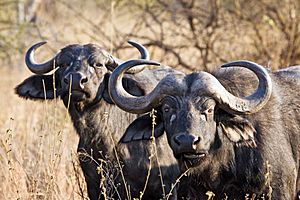
Animals use their horns and antlers for many important reasons:
- Protection: They use horns to defend themselves from predators.
- Fighting: Animals might fight other animals of their own kind. This can be for their territory, to show who is strongest, or to find a mate.
- Gender Differences: Usually, only male animals have horns. But in some species, females also have horns.
- Defense Strategy: Scientists think that taller animals living in open areas might use horns more for defense. This is because they are easier for predators to spot. Female bovids (like cows and buffalo) that live in open areas are more likely to have horns than smaller or camouflaged species.
- Finding Food: Some animals use their horns to dig in the soil or to strip bark from trees.
- Attracting Mates: During courtship, many animals use their horns in special displays. For example, a male blue wildebeest might rub his horns on trees. This helps him impress a female and attract her to his territory.
- Cooling Down: Some animals with true horns use them to stay cool. The horns have blood vessels inside their bony core. This allows them to work like a radiator, helping the animal release heat.
After a horned animal dies, the larvae (young) of the Horn Moth might eat the keratin from the horns.
Related pages
- Antlers, structures similar to horns
Images for kids
-
A pair of horns on a male impala
-
A Water buffalo horn used as a hammer to cut fish in southeast China
-
A Hebridean sheep with one horn on one side and two on the other
-
An Art Nouveau necklace made from horn by Elizabeth Bonté
-
Sable antelope horns on display at the Zoological Museum, Denmark
-
Horns, tusks, and antlers in the National Museum of Scotland
See also
 In Spanish: Cuerno para niños
In Spanish: Cuerno para niños


